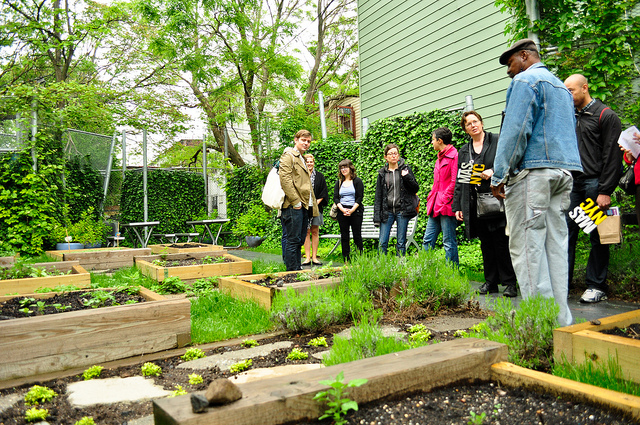
Re-imagining the Civic Commons
Above: A Jane’s Walk tour or historic Little Italy in New York. Photos by MAS-NYC.
In the past cities included in zoning plans and land use guides provision for a variety of common civic spaces and places accessible to the public such as parks, libraries, settlement houses, post offices, community centers, health clinics and hospitals, markets and public schools. These key facilities formed the backbone of any city’s “civic commons”: a network of publicly financed and managed amenities to serve the broader, collective needs of local neighborhoods and to benefit the city as a whole. They provided much-needed public services, but also opportunities to foster neighborhood identities, cultural expression, learning, a sense of belonging, and serendipity and surprise. Throughout history, the civic commons has made the city a city: It’s where we voted, where key decisions were made, we expressed our collective aspirations, and where we went to celebrate, learn, trade, play, and maybe just rest. Related Link
“The Municipal Art Society of New York will develop a model for reinventing civic spaces-libraries, parks, schools and community centers-with $250,000 from Knight Foundation” — July 17, 2014 press release
But urban life is continually changing, and so too are people’s needs and use of the civic commons. Re-Imagining the Civic Commons is a national inquiry funded by Knight Foundation, managed by the Municipal Art Society of New York, a civil society advocacy organization focused on effective policy and leadership initiatives that foster urban livability and resilience. Our goal is to build a national provocation, and later this year to make the case for a reimagined civic commons which will be so compelling that city leaders will embrace it, and commit to new ways to create, manage and invest in it.
We aren’t using the elements of the civic commons the way our parents did. Where do you see the civic commons in your neighborhood, and who is using it? Institutions (churches, settlement houses, community and cultural centers) that traditionally offered opportunities for mutual aid and interaction across differences of class, race and ethnicity seem to be less central to contemporary urban life. Many of us spend a substantial part of our working day commuting – by car, or train, or bus or subway – which not only affects the amount of time we may have to spend taking advantage of the civic commons, but also our disposition towards funding it.
In some cities we see some people opting out of the civic commons: spending more time watching television at home and exercising in their private health club, rather than going to the library or using their local park. As city budgets are pressed, it’s easy to see why governments might opt to reduce service hours, shutter old community centers, sell off community hospitals or local post offices, or abandon costly public spaces.
At the same time, urban dwellers continue to find new ways of sharing and making connections. In your city, what kinds of activities take place in public spaces and places? Attractive public spaces and parks are often full of groups and individuals. Libraries seem to be oversubscribed with people and families participating in every kind of program. Co-working and maker spaces are thriving. So are coffee shops. Digital technologies continue to create a remarkable web of urban interconnectedness – a digital commons –that allow those with Internet access to share a ride, a service, meet up with a group with similar interests, order a book, find an event. What can we learn from successful places and shared experiences that can inform how we design, build and manage the new civic commons?
Working closely with the Municipal Art Society to help curate this process is WXY Studio, an architectural practice led by Claire Weisz whose firm has a special interest in public space and programming. In addition to user research and observation, the project team is consulting extensively with urban practitioners working in cities across the country, including designers, planners, artists, entrepreneurs, as well as the myriad of people who conceive, manage and finance particular elements of the civic commons. This includes targeted sessions with stakeholders in a number of cities including the Knight communities of Charlotte, N.C., and San Jose, Calif., and the cities of Chicago, San Francisco and New York. The team is also working in tandem with a similar initiative in Canada funded by the J.W. McConnell Foundation, exploring the potential uses of public buildings – civic assets – that governments are finding it challenging to continue to maintain and program. The initiative will report out its preliminary findings at the annual MAS Summit for New York City, Oct. 23-24, 2014.
Mary Rowe is director, urban resilience and livability, for The Municipal Art Society of New York, which will help reimagine civic spaces with the support of Knight Foundation.
Photo: A community food walk in Bed-Stuy organized by Jane’s Walk. Photo: MAS-NYC.
Recent Content
-
Communitiesarticle ·
-
Communitiesarticle ·
-
Communitiesarticle ·



